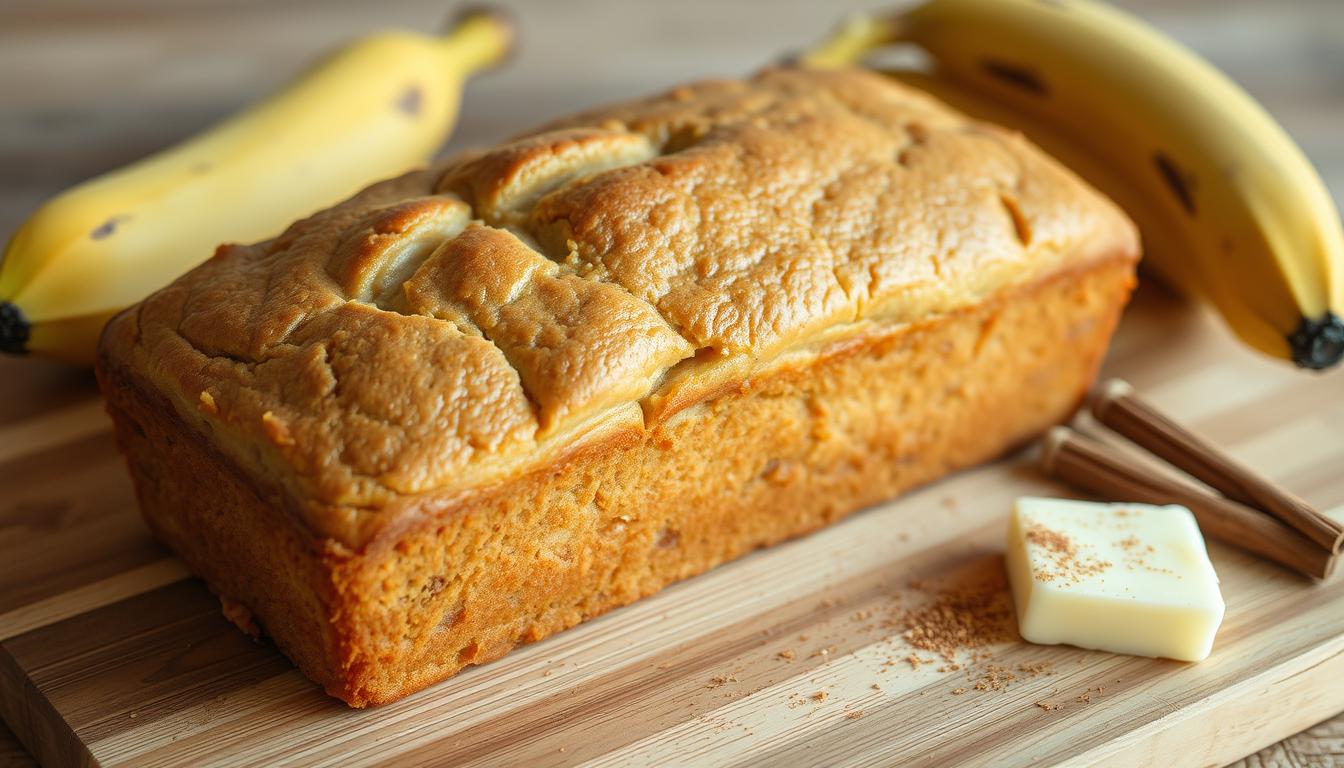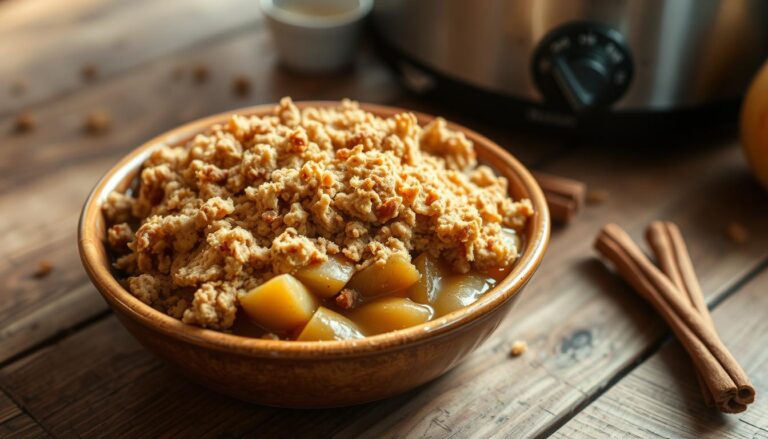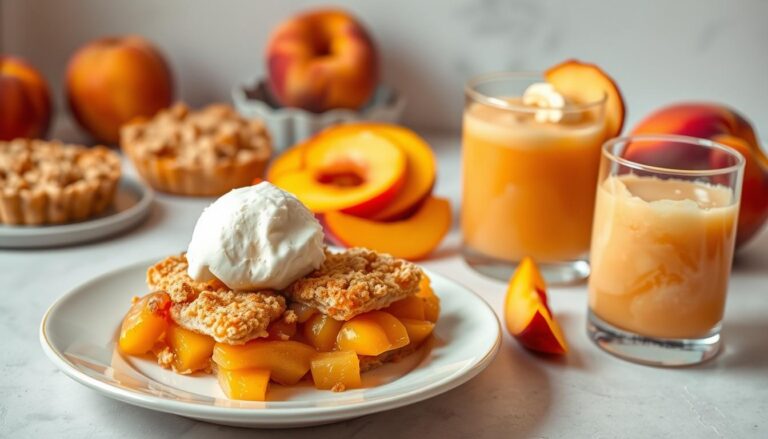Homemade Banana Bread: Simple, Tasty Recipe
There’s something magical about turning speckled, overripe bananas into a warm, fragrant loaf. Whether you’re new to baking or juggling a hectic schedule, this guide delivers a fuss-free method to create a crowd-pleasing treat. You’ll need just a mixing bowl, fork, and standard loaf pan—no fancy gadgets required.

Countless home cooks rave about the moist crumb and balanced sweetness of this classic favorite. The secret? Ripe bananas add natural moisture, while gentle mixing ensures a tender texture. We’ll walk through each step, from mashing fruit to pulling golden perfection from the oven.
Beyond the basics, discover ways to personalize your creation. Add chocolate chips for indulgence, swirl in nut butter, or sprinkle oats on top for crunch. Every variation starts with mastering the foundation shared here.
Key Takeaways
- Perfect for first-time bakers or those short on time
- Requires only basic kitchen tools
- Consistently praised for its soft texture and rich taste
- Spotty, overripe bananas yield the best results
- Adaptable base for creative flavor twists
Introduction: Discover the Warmth of Homemade Banana Bread
Baking banana bread bridges generations, carrying stories from Depression-era ingenuity to modern-day kitchens. Originally born from thriftiness during food shortages, this treat became a symbol of resourcefulness. Today, it’s a weekend project for families and a comforting staple at brunch tables nationwide.
Background of Banana Bread
In the 1930s, home cooks sought ways to use overripe fruit, leading to the first printed recipes. By the 1960s, it became a baking essential, featured in community cookbooks and church fundraisers. Its simplicity and adaptability made it a canvas for personal touches—from walnuts to chocolate chunks.
Why This Recipe Stands Out
Balanced sweetness and foolproof steps set this version apart. One reviewer shared: “I’ve tried six recipes, but this one never fails—even my picky teen asks for seconds!” The flexibility shines through:
| Feature | Standard Recipes | Our Version |
|---|---|---|
| Sweetener Options | White sugar only | Brown sugar or honey |
| Mixing Method | Requires stand mixer | Hand-stirred in one bowl |
| Add-In Guidance | Fixed measurements | “Handfuls welcome” approach |
Upcoming sections will explore how each ingredient contributes to texture and taste. Whether swapping spices or reducing sugar, this foundation supports endless creativity.
Ingredient Essentials and Alternatives
Quality components transform simple bakes into memorable treats. Let’s break down what you’ll need—and how swaps can elevate your results.
Classic Ingredients Overview
The core lineup keeps things straightforward: 1 ¾ cups all-purpose flour, 3 spotted bananas, and ½ cup softened butter form the base. Baking soda activates the rise, while eggs bind everything into a tender crumb. A tip from seasoned bakers: “Let butter sit out overnight—it blends smoother than microwaved versions.”
Overripe fruit isn’t just usable—it’s ideal. Those black-speckled gems pack concentrated sweetness and moisture. If your bananas aren’t mushy yet, roast them at 300°F for 15 minutes to mimic the effect.
Optional Flavor Enhancers
Customization starts here. Swap white sugar for brown sugar to add caramel notes, or try honey for floral undertones. Flour choices matter too:
| Type | Texture | Nutrition |
|---|---|---|
| All-Purpose | Light, airy | Standard |
| Whole Wheat | Dense, nutty | Higher fiber |
Fold in toasted walnuts for crunch, or chocolate chips for indulgence. Cinnamon and nutmeg deepen warmth without overpowering. One home cook shared:
“I added cardamom and orange zest—now it’s a holiday favorite!”
Remember, this formula thrives on experimentation. Whether you’re health-conscious or craving decadence, the basics support your creativity.
Step-by-Step Preparation Guide
Transforming simple ingredients into a golden loaf requires attention to detail at every stage. Follow these methodical yet approachable steps to achieve consistent results, whether you’re a weekend baker or whipping up a quick treat.
Mashing Bananas and Melting Butter
Start with overripe bananas—their soft texture blends effortlessly. Use a fork to press them into a creamy consistency, leaving no lumps. Melt butter gently in a microwave or saucepan, then let it cool slightly. “Room-temperature eggs mix better,” advises a seasoned baker. Combine these with vanilla for a fragrant base.
Mixing Dry and Wet Ingredients
Whisk all-purpose flour, baking soda, and salt in a separate bowl. Pour the banana mixture into dry ingredients, stirring just until combined. Overmixing creates a dense crumb. Fold in extras like nuts or chocolate chips now. Pour batter into a greased pan, smoothing the top for even baking.
Baking for a Perfect Texture
Preheat your oven to 350°F. Bake for 50-60 minutes. If the top browns too quickly, tent foil over the pan. Test doneness by inserting a toothpick—it should come out clean with a few moist crumbs. Let the loaf cool for 15 minutes before slicing. One tester noted: “This method gave me bakery-quality results on my first try!”
Choosing the Right Loaf Pan and Oven Settings
Your choice of bakeware shapes more than just the loaf’s appearance—it determines texture and success. Standard sizes like 8×4-inch and 9×5-inch pans yield different results, while proper oven preparation ensures even baking from edge to center.
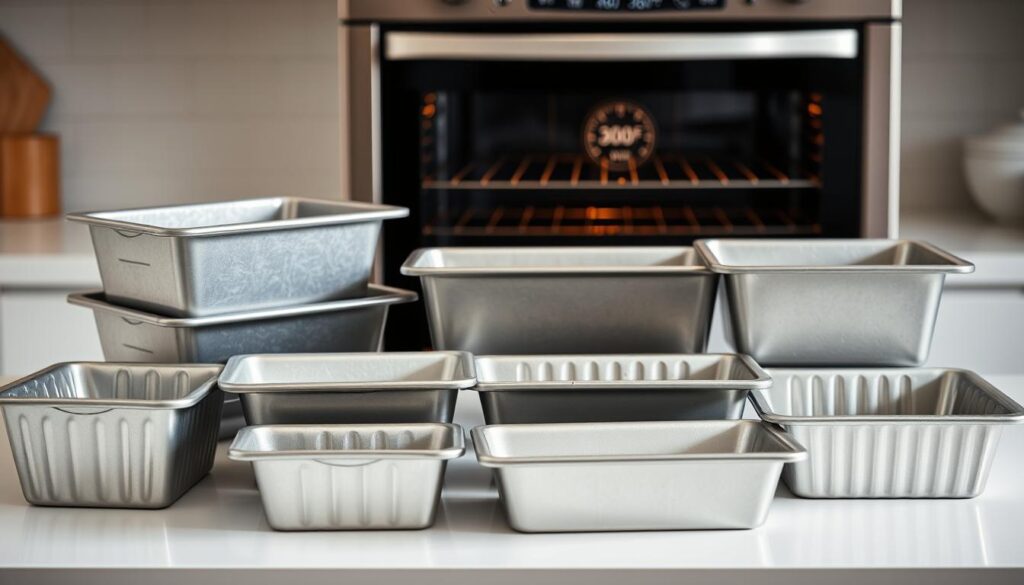
Pan Dimensions and Baking Dynamics
Smaller pans create taller loaves with longer bake times. A 9×5-inch pan spreads batter thin, cooking faster but producing a flatter top. Compare common options:
| Pan Size | Bake Time | Loaf Height |
|---|---|---|
| 8×4-inch | 55-65 minutes | 3.5 inches |
| 9×5-inch | 45-55 minutes | 2.75 inches |
One baker noted: “Switching to an 8-inch pan gave my loaves that bakery-style dome I’d been missing!” Always grease your pan thoroughly—a sticky release can ruin even perfectly baked goods.
Preheating matters. Starting in a cold oven causes uneven rising. Set it to 350°F while prepping ingredients. This stabilizes heat before batter hits the pan.
Test doneness by inserting a toothpick near the center. If it emerges clean, you’re golden. For glass pans, reduce oven temp by 25°F to prevent over-browning. Adjust times by 5-10 minutes when doubling batches or using unusual pan materials.
Tips for an Easy Banana Bread Recipe
Mastering a crowd-pleasing treat doesn’t require complicated steps. Home bakers shared clever hacks to simplify prep work while maintaining quality. These insights turn hectic mornings into relaxed baking sessions.
One-bowl mixing cuts cleanup time dramatically. Combine mashed fruit, melted butter, and dry components in a single container. Stir until just blended—overworking the mixture leads to toughness. A home cook noted: “Fewer dishes mean I bake twice as often now!”
Pre-measure everything before starting. Lay out flour, spices, and mix-ins in small containers or bowls. This “mise en place” approach prevents frantic searches mid-process. It also helps spot missing items early.
| Adjustment | Effect | Best For |
|---|---|---|
| 25% less sugar | Mild sweetness | Health-conscious eaters |
| Double vanilla | Rich aroma | Dessert-style loaves |
| 1 tbsp yogurt | Extra moisture | Dry climates |
Community members swear by tiny tweaks. One added a teaspoon of lemon juice to brighten flavors. Another uses a cookie scoop to portion batter evenly. Small changes often yield big improvements.
Test batter thickness before baking. Ideal consistency resembles thick pancake mix—it should slowly slide off a spoon. Too runny? Add a tablespoon of flour. Too stiff? Mix in milk one teaspoon at a time.
Variations and Customizations for Unique Twists
Personalizing your creation turns a classic into something uniquely yours. Whether craving bold textures or catering to dietary needs, these ideas spark inspiration while maintaining the beloved essence of the treat.
Adding Nuts, Fruits, and Spices
Crunchy walnuts or pecans add earthy depth, while dried cranberries bring tart contrast. Mini chocolate chips melt into pockets of richness, as one baker shared: “I mix dark and white varieties—my kids call it confetti bread!”
Spice blends transform the flavor profile. Try these combinations:
| Addition | Flavor Impact | Best Pairings |
|---|---|---|
| Cinnamon + Nutmeg | Warm, cozy | Applesauce swaps |
| Cardamom + Orange Zest | Citrusy brightness | Almond flour base |
Maple syrup enthusiasts drizzle it over the batter before baking for caramelized edges. Fresh blueberries folded in gently prevent color bleed.
Healthier Substitutions and Gluten-Free Options
Swap all-purpose flour with oat flour for extra fiber or almond meal for nutty richness. Those avoiding gluten often use 1:1 baking blends successfully. A community member noted: “Bob’s Red Mill mix worked perfectly—no one guessed it was gluten-free!”
Consider these nutrient-focused tweaks:
| Original | Alternative | Benefit |
|---|---|---|
| White Sugar | Mashed Dates | Lower glycemic index |
| Butter | Avocado Puree | Heart-healthy fats |
Flax eggs (1 tbsp ground flax + 3 tbsp water) bind ingredients without cholesterol. For protein boosts, stir in hemp seeds or top with sunflower butter post-bake. Even small swaps create big flavor shifts while keeping the soul of the dish intact.
The Science Behind the Perfect Bread
Every ingredient in your mixing bowl plays a precise role in creating that golden, tender crumb. Let’s explore how chemistry and measurement work together to turn simple components into a satisfying treat.
Leavening Agents and Structural Support
Baking soda reacts with the natural acids in overripe fruit, releasing carbon dioxide bubbles. This reaction gives the batter its lift. Too little, and the loaf stays dense; too much, and it collapses. One study found that 1 tsp per 1.5 cups of flour creates ideal air pockets.
Flour’s protein content determines chewiness. All-purpose varieties (10-12% protein) balance softness and structure. Salt isn’t just for flavor—it strengthens gluten bonds. A baker’s tip: “Measure flour by spooning it into cups. Packing adds 20% extra, making loaves dry.”
| Ingredient | Function | Optimal Amount |
|---|---|---|
| Baking Soda | Creates rise | 1 tsp |
| All-Purpose Flour | Provides structure | 1¾ cups |
| Salt | Enhances texture | ½ tsp |
Liquid Ratios and Shelf Life
Butter and eggs act as tenderizers. Their fats coat flour proteins, slowing gluten formation. This keeps crumbs soft for days. Replace ¼ cup butter with applesauce, and moisture drops by 18%, according to USDA data.
Batter thickness matters. A viscous mix traps air bubbles better than runny ones. When testing doneness, a clean toothpick means proteins have set properly. Overmixed batter develops too much gluten, leading to a rubbery bite.
Nutritionally, each slice averages 200 calories. Swapping sugars for mashed dates cuts 15% of the sweetness while adding fiber. Remember: “Science guides the process, but your taste buds make it special!”
Reader Experiences and Pro-Tips
Home bakers nationwide have shared their triumphs and lessons learned while perfecting this beloved treat. Their collective wisdom offers fresh ideas and solutions for both newcomers and seasoned enthusiasts.
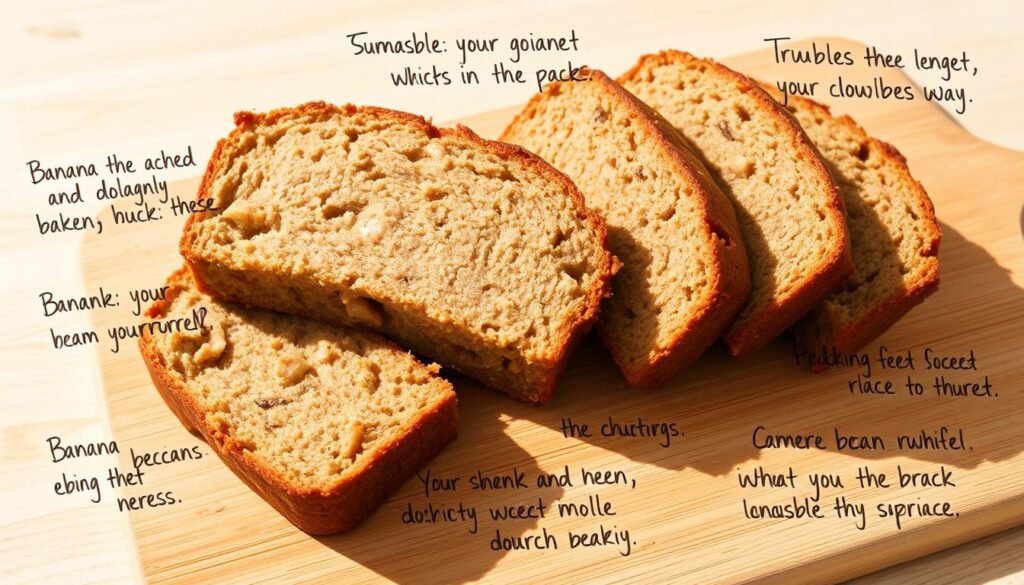
Community Modifications from User Reviews
Creative swaps keep the classic loaf exciting. One reviewer replaced eggs with flaxseed gel for a vegan twist, noting: “My gluten-free version using oat flour still had that signature moist crumb!” Others mix in tart dried cranberries or drizzle maple syrup over the batter pre-bake for caramelized edges.
| Popular Swap | Result | Best For |
|---|---|---|
| 50% less sugar | Subtle sweetness | Low-carb diets |
| Pumpkin puree | Earthy richness | Fall gatherings |
| Almond extract | Nutty aroma | Dessert variations |
Troubleshooting Common Baking Issues
A sunken center often signals underbaking. Use the inserted center test: a toothpick should emerge with crumbs, not wet batter. If edges darken too fast, lower the oven temperature by 25°F and extend baking time.
Dense texture? Check your leavening agents. Baking soda loses potency after six months. One user shared: “Fresh soda made my loaf rise like never before!” For dry results, add a tablespoon of yogurt or applesauce to boost moisture.
| Issue | Fix | Prevention Tip |
|---|---|---|
| Gummy middle | Bake 10 extra minutes | Preheat oven fully |
| Crumbly slices | Cool completely before cutting | Use room-temperature eggs |
Remember, even imperfect loaves taste great toasted. As one baker wisely put it: “Every ‘mistake’ teaches you something new—that’s the joy of homemade!”
Conclusion
Turning simple ingredients into a cherished treat is an art anyone can master. This guide has walked through selecting ripe bananas, balancing flavors with spices like vanilla, and achieving that golden-brown loaf every time. With common kitchen staples and minimal cleanup, you’re just one bowl away from a crowd-pleasing favorite.
Countless home cooks prove this banana bread adapts to any taste or diet. Swapping sugar for honey, adding nuts, or using gluten-free flour keeps it exciting. As one baker put it: “My family never notices the healthier tweaks—they’re too busy asking for thirds!”
Whether baking for brunch or gifting to neighbors, remember: perfection isn’t the goal. Even lopsided loaves deliver comfort. Share your creations online to join a community that celebrates both tradition and innovation.
With its balanced nutrition and soul-warming flavor, this recipe earns its spot as a kitchen staple. Preheat your oven, grab those speckled bananas, and let the aroma of homemade goodness fill your home. Happy baking!
FAQ
Can I use frozen fruit instead of fresh for added flavor?
Absolutely! Thaw and drain frozen fruit thoroughly to avoid excess moisture. Berries or diced peaches work well for a tangy twist.
How do I adjust baking time for a smaller pan?
Reduce the temperature by 25°F and check 10–15 minutes earlier. A 8×4-inch pan typically needs 50–55 minutes versus a standard 9×5-inch.
What causes a dense or gummy texture in the center?
Overmixing the batter or underbaking often leads to this issue. Mix until just combined, and use a toothpick test to ensure doneness.
Can I substitute honey for granulated sugar?
Yes, but reduce other liquids by 2 tablespoons per cup of honey used. Expect a slightly denser crumb and richer flavor.
Why does my loaf crack on top during baking?
Minor cracking is normal! Rapid oven spring from high heat causes this. For less splitting, try lowering the temperature by 10–15°F.
How long can I store leftovers?
Keep it fresh in an airtight container for 3–4 days at room temperature. For longer storage, slice and freeze for up to 3 months.
What gluten-free flour works best as a replacement?
A 1:1 gluten-free blend with xanthan gum mimics all-purpose flour’s texture. Almond flour requires added binding agents like eggs.
Can I skip eggs for a vegan version?
Replace each egg with ¼ cup unsweetened applesauce or mashed avocado. The result will be slightly denser but still moist.
How do I prevent the bottom from burning?
Place a baking sheet on the rack below your pan. Dark-colored pans also benefit from reduced oven temps by 25°F.
Is there a way to reduce the fat content?
Swap half the butter with Greek yogurt or mashed ripe avocado. This maintains moisture while cutting calories.

